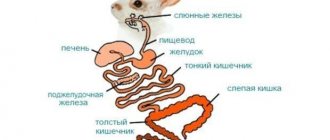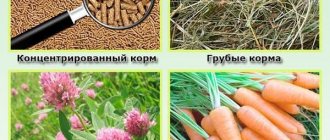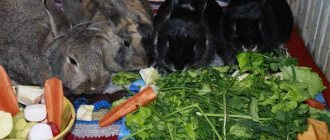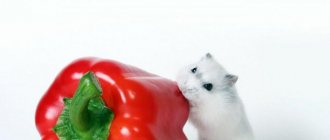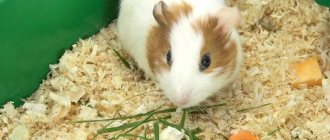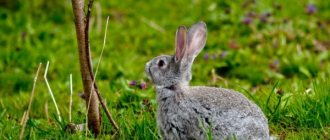Owners of rabbit farms are interested in the question of whether rabbits can eat peas. Many people grow this crop in their gardens; it can be a good help for farmers. From this article, readers will learn at what age it is allowed to introduce peas into the diet of long-eared animals, whether tops and pods can be given, and how to properly feed animals with such food.
Feeding the rabbit peas
Is it possible to feed rabbits peas?
Legumes are a valuable source of easily digestible proteins, vitamins and minerals. Despite the fact that they can provoke bloating and colic if consumed in excess, they are indispensable as food for rabbits, especially in the cold season .
Peas are especially useful. This is an affordable, healthy crop that is easy to prepare for the winter in sufficient quantities. But in order for rabbits to receive only benefits from peas, the animals must be fed strictly according to the rules. In this case, feeding peas will only be beneficial; the rabbits will be strong, healthy, and resistant to diseases. They will be active, gaining weight well, with a smooth, silky skin.
Green peas
Fresh green peas, fresh from the garden, are contraindicated for rabbits. The presence of moisture in it can enhance fermentation processes in the digestive organs, which will cause the development of disease and deterioration in the well-being of animals. But if the pods or shelled green peas are slightly dried and withered, the risk of flatulence can be reduced to zero.
During the drying process, the amount of liquid in the pods and peas decreases, but the nutrients do not decrease. Such peas are better digestible and beneficial, especially as a green supplement during winter feeding, when there is an acute lack of nutrients and vitamins.
Tops
This product is no less healthy and tasty by rabbit standards. After growing green peas, a lot of green mass remains in the beds. The most competent method of preparation is drying for the winter, since at this time of year colic especially needs high-calorie and vitamin nutrition. Fresh tops are not given to animals because of the excessive amount of moisture, which causes pain and colic in the abdomen. The collected tops are dried and then given to rabbits as a supplement, but not the main food.
See also
How does a female rabbit behave before giving birth and how many days does it take to prepare the nest? Read
Dry peas
Stocking up on dry peas is a great way to make your rabbits' winter food plentiful and varied. This is especially important for feeding pregnant and lactating females, as well as when raising animals in unheated rooms or outdoors. However, dry peas in unprocessed and unprepared form are not given to rabbits. Unlike green varieties of food, which are pre-dried, hard dry peas are soaked, processed and fed according to a special pattern.
It is imperative to follow the recommendations for the preparation of pea feed, since non-compliance will cause refusal of food in the best case and death of the rabbits in the worst situation. In addition to peas, other legumes can be included in the diet of rabbits - beans, soybeans, lentils, and beans. At the same time, the principles of serving and processing are preserved, that is, the stems, pods and other greens from the plants are slightly dried, removing excessive moisture, and the fruits are steamed, crushed or crushed into puree. In this case, legumes are perfectly eaten and digested without problems.
However, you cannot abuse such food, much less make it the main food product. Legumes should be a healthy addition, but not a staple.
Among the plants of the legume family, alfalfa greens are also fed to rabbits as food, including in the form of hay in the cold season. This is a very healthy food that helps increase body weight and improve the health of animals.
Contains protein
In terms of nutritional content, peas are an excellent food for rabbits. It is rich in nutritious proteins, is well absorbed by animals, and promotes rapid gain of live weight.
Feeding rabbits must be varied, so it is recommended to add peas to specialized grain feeds in an amount of no more than 10% of the total volume. It is important to ensure free access to drinking water.
The nutritional value of 1 kg of dry peas is 1.17 feed units. It contains 173 g of digestible protein, protein - 195 g, calcium - 1.74 g, phosphorus - 4.18 g, lysine - 14.2 g, crude fiber - 54 g. One feed unit requires 0.9 kg of this legume plants.
It is not recommended to give fresh, just picked peas to a rabbit, as well as dried fruits of this legume. Peas are highly hygroscopic, so they should be soaked in hot water to prevent unwanted swelling in the body.
Feeding rules
Any pea food must be prepared before serving to rabbits. If withering is enough for green peas in pods and collected fresh tops, then dry and shelled peas need to be turned into a pulp and added to other feeds. To obtain the product proceed as follows:
- Dry or green split peas in a clean, washed form are placed in a large container with the expectation that the volume of the finished product will at least double.
- Pour in twice as much boiling water as the amount of legumes.
- Add half a tablespoon of table salt for every liter of liquid.
- Leave to swell and infuse for 2 hours.
- Dried swollen peas are mixed with bran, grated root vegetables - carrots, beets, silage.
- Green peas are pureed and added to grain or feed.
See also
Full description of giant rabbit breeds, their breeding and rearingRead
In winter, adult rabbits and pregnant rabbits are given 50-60 grams of pea puree or steamed grain per day; nursing mothers are given up to 100 grams. Babies over 1-2 months are given 20 grams, three-month-olds – 30 grams, four-month-olds – 40 grams, rabbits over 4 months old are given an “adult” portion – up to 60 grams.
In the summer, peas in various forms, including tops, are added to regular feed no more than 2 times a week. The pods, once dried, can be used in minimal quantities as a treat for domestic rabbits living as pets in the house.
Feeding rules
For ordinary rabbits, the portion of peas in the daily menu should not exceed 8% of the weight of the total food per day. This amount is quite enough to provide animals with protein, but not to overload their gastrointestinal tract.
When feeding peas to rabbits, the product must first be prepared for feeding, regardless of the form in which it is used. You cannot prepare such food for future use; preparation is carried out shortly before feeding.
Tops
For distribution to animals, use fresh green mass without traces of dirt or rot. The product, as a rule, is pre-dried a little (withered), fed in a mixture with other herbs or separately. Do not give rabbits tops that are wet from dew or rain; they cause stomach upset in animals. Dry tops, prepared in advance in the summer, will especially appeal to the entire livestock in the winter months.
Green peas
To feed such a product, it is first dried (withered), removing excess moisture. To eliminate possible pathogens, you can pour boiling water over the grain or pods. Rabbits are offered this food separately with other vegetables, root crops or mixed with grain from other crops.
Dry peas
In crushed form, dry peas are used as part of self-prepared feed mixtures. All grain is ground and lightly moistened before being distributed to the rabbits. This allows you to remove flour that may get into the animals' noses.
When feeding whole grain, it is given to rabbits in steamed form. First, it is washed to remove dirt, then it is poured with boiling water in a ratio of 1 to 2, the container is covered with a lid and left to swell for at least 2 hours, then it is fed to the rabbits mixed with other food. You can add a little salt to the water, which will also be beneficial for animals.
Possible contraindications and harm
Because peas and other legumes can cause bloating, the amount and frequency of use should be limited. They should not become the basis of a rabbit's diet, otherwise they will develop digestive problems.
If a rabbit eats a little too much properly cooked peas, nothing dangerous will happen to him. He will have colic, which will cause discomfort and restlessness, possibly bloating and indigestion. It will pass after some time. It is important to immediately draw conclusions and stop overfeeding animals with legumes.
It’s another matter if peas are given without prior preparation. This can cause serious health problems and even death for rabbits. This is especially dangerous for pregnant and pregnant rabbits, as well as small rabbits.
It is believed that peas and other similar foods can be given to babies older than 1-2 months, little by little at first, monitoring their health. If signs of illness appear, peas should be removed from the menu for a while. Pea mash and puree are useful for nursing rabbits, as they help enhance lactation and improve the quality of milk. But here, too, moderation and proper preparation of ingredients are important for success.
Great for winter diet
Despite the benefits of legumes, the main thing in feeding a rabbit is variety. In addition, it should be remembered that long-eared animals should not starve, as this can lead to stagnation in their intestines.
Dry peas are excellent for the winter rabbit diet, since they can even compete with green feed in terms of the content of nutrients.
This product goes well with chopped carrots, beets, hay, and silage. It should be remembered that it is always better to steam peas, because due to their hygroscopicity, they actively absorb any moisture and can swell inside the rabbit’s stomach.
Read our article “Orange peels for a rabbit: can you give them” so as not to doubt what treats you can offer your pet.
What do you think about the pea menu for rabbits? If the article aroused interest and answered some important questions, please like it.
Share interesting information on social networks. Leave your comments.
One of the main principles of good growth and weight gain in rabbits is a complete and properly balanced diet, which contains the entire range of substances beneficial to the animal. Only in this case can a healthy livestock be achieved. Many novice rabbit breeders ask questions: can rabbits eat peas, and will this food harm them?
Along with grass and grain crops, peas form the basis of food for domestic hares. The fact is that rabbit teeth are constantly growing, and the animal constantly needs to gnaw something so that the excess dental tissue is worn down.
If legumes are present in abundance in the diet for rabbits, the animals should have a sufficient amount of fresh water in their drinking bowls. It needs to be changed every day to prevent intestinal infection.
You can give your rabbits fresh or slightly dried greens, carrots, pumpkin, and zucchini. Peas are also an excellent food for these rodents. It is rich in protein and is well absorbed by animals, so they quickly and steadily gain body weight. It is also included in specialized rabbit feeds. But at the same time, it is necessary to take into account a number of features that every owner who feeds rabbits with such food should know.
Steaming
The steaming procedure makes the food sweet and soft, its digestion improves, it is absorbed more actively, and the little ears will eat it with appetite. To do this, grain of one type or a mixture of cereals is poured into a bucket, but not to the brim. Leave 10 cm in the expectation that the volume of the contents will increase after steaming. Pour boiling water, add tbsp. l. salt, mix the composition and cover the bucket with a lid. In 5 hours the “dish” will be ready.
Products increase the formation of mucus in the intestines and cause fermentation processes, which leads to bloating.
It is prohibited to feed rabbits with baked goods and fresh white bread.

